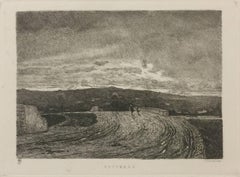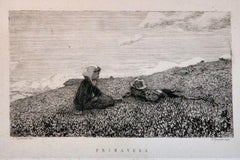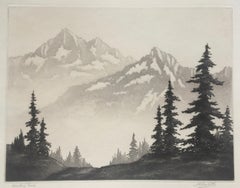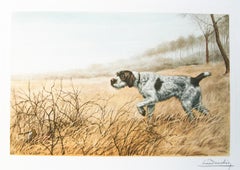Telemaco Signorini Prints and Multiples
to
2
Overall Width
to
Overall Height
to
2
1,170
922
886
814
2
2
2
1
1
1
1
1
1
1
2
2
Artist: Telemaco Signorini
Novembre
By Telemaco Signorini
Located in Roma, IT
Signed the plate with the artist's monogram “TS”lower left. Inscription “C. Lovera imp” lower right. Very rare print from “L'Art in Italia”, 1871.Original Prints.
Image Dimensions : ...
Category
1870s Realist Telemaco Signorini Prints and Multiples
Materials
Etching
Spring - Original Etching by Telemaco Signorini - 1873
By Telemaco Signorini
Located in Roma, IT
Landscape and figures. Signed on plate.
Image Dimensions : 15x21 cm.
Publisher : Editore Lovera
Excellent conditions
This artwork is shipped from Italy. Under existing legislation, ...
Category
1870s Realist Telemaco Signorini Prints and Multiples
Materials
Etching
Related Items
WESTERN PEAKS
By Harold Lukens Doolittle
Located in Santa Monica, CA
HAROLD LUKENS DOOLITTLE (1873 - 1974)
WESTERN PEAKS c. 1945
Aquatint signed and titled in pencil. 6 3/4 x 8 7/8 sheet 9 5/8 x 12 3/4.
Good condition save for just a hint of darkening within the window and small bits if tape on the sheet edge verso.
Doolittle was a renaissance man. His day job was as an engineer for the Edison Electric Co. But he produced an outstanding body of prints for 5 decades as well as photographs. His very rare arts and crafts furniture is highly sought after. He was a long time member and officer in the California Print...
Category
1940s Realist Telemaco Signorini Prints and Multiples
Materials
Aquatint
Griffon With Woodcock original signed etching by Leon Danchin
By Leon Danchin
Located in Paonia, CO
Griffon With Woodcock is an original etching by Leon Danchin showing a Griffon in a field pointing at a Woodcock trying to hide in the brush. This color etching is in good conditi...
Category
20th Century Realist Telemaco Signorini Prints and Multiples
Materials
Etching
$950
H 20.5 in W 31.5 in
LE PETIT CAVALIER SUR BOIS.
By Jean Baptiste Corot
Located in Santa Monica, CA
JEAN-BAPTISTE CAMILLE COROT (1876 - 1875)
LE PETIT CAVALIER SUR BOIS. 1854 (1921) (Delteil 42)
Cliché-verre on thin vellum. Signed in plate at bottom. 8 1/4 x 6 5/16” (sheet size)....
Category
1850s Realist Telemaco Signorini Prints and Multiples
Materials
Photographic Paper, Etching
Limehouse
By James Abbott McNeill Whistler
Located in New York, NY
James McNeill Whistler (1834-1903), Limehouse, etching, 1859. References: Glasgow 48, fifth state (of 6), Kennedy 40, third state (of 3), signed with the butterfly in pencil in the lower margin. [Also signed and dated in the plate.]With margins, 5 x 7 7/8 inches, the sheet 6 1/2 x 9 1/2 inches. Published as no. 12 in A Series of Sixteen Etchings of Scenes on the Thames and Other Subjects, otherwise known as the Thames Set. In good condition apart from a soft diagonal fold in the sky.
A very fine impression, in black ink on a thin Japan paper.
Provenance: Dr. John W. Randall (cf. Lugt 2130), without his mark, annotated on the mat.
Limehouse, the entrance to the West Indies Docks, lies opposite the Surrey Commercial Docks in Rotherhithe, along the lower Thames.
It’s unusual to find the signed butterfly (or any pencil signature) on the early London etchings, but it is known that Whistler signed...
Category
1850s Realist Telemaco Signorini Prints and Multiples
Materials
Etching
Le Bourg de Batz
By William Strang, R.A., R.E.
Located in New York, NY
William Strang (1859-1921), Le Bourg de Batz, etching and drypoint on copper, 1913, signed in pencil lower right [also signed and dated in the plate]. Refere...
Category
1910s Realist Telemaco Signorini Prints and Multiples
Materials
Drypoint, Etching
19th century black and white etching landscape circular print river signed
By Edward Loyal Field
Located in Milwaukee, WI
"The Boat House" is a signed (lower center) etching by Edward Loyal Field. It depicts a scene across a river in the foreground, where a quaint set of houses sits in black and white.1...
Category
1880s Realist Telemaco Signorini Prints and Multiples
Materials
Etching
Doorway of the Doges, Venice
By Donald Shaw MacLaughlan
Located in New York, NY
Donald Shaw MacLaughlin (1876-1938), Doorway of the Doges, Venice, etching with plate tone, 1909, signed bottom right [also signed and dated in the plate]. Reference: Marie Bruette 1...
Category
Early 1900s Realist Telemaco Signorini Prints and Multiples
Materials
Etching
L’Hiver a Paris ou La Neige a Paris
By Félix Hilaire Buhot
Located in New York, NY
Felix Buhot (1847-1898), L’Hiver a Paris ou La Neige a Paris, 1879, etching, aquatint, drypoint, roulette. [signed and dated in the plate Felix Buhot Par...
Category
1870s Realist Telemaco Signorini Prints and Multiples
Materials
Drypoint, Etching, Aquatint
LE PONT AU CHANGE
By Charles Meryon
Located in Portland, ME
Meryon, Charles. LE PONT AU CHANGE. S.40(v), DW.34. Etching with drypoint, 1854. Fifth State of twelve, with the inscriptions in cursive, "C. Meryon del. sculp. mdcccliiii," lower l...
Category
1850s Realist Telemaco Signorini Prints and Multiples
Materials
Drypoint, Etching
The Unsafe Tenement
By James Abbott McNeill Whistler
Located in New York, NY
James Abbot McNeill Whistler (1834-1903), The Unsafe Tenement, etching, 1858. [signed in the plate lower right]. References: Kennedy 17. Glasgow 18, fourth state (of four). In very good condition, printed on a very thin (two ply?) Japan paper, with margins, 6 1/8 x 8 3/4, the sheet 8 1/4 x 11, archival mounting.
A brilliant, black impression printed with astonishing clarity and exquisite detailing, on an ivory Japan paper. Presumably this is a proof impression before the relatively large edition published in this state (the edition was not on this paper).
Provenance: Inscribed “To Otto J. Schneider from his friend Frederick Keppel”. Schneider (1875-1946) was an American artist, noted for his realism, influenced by Whistler. Keppel was of course the well-known American dealer, one of whose specialties was Whistler prints. Keppel had a good relationship with Whistler until, as in most of his relationships, Whistler became inordinately troublesome – at which point Keppel wrote Whistler a longish, mocking poem, with lines such as these: “Like cackling hens or cocks a-crowing Your tireless trumpet keeps a-blowing. ” After this, Keppel wrote “at this point all my intercourse with this extraordinary man came to an end.”
(In the lower right is the ghost of another inscription, now erased, apparently to another friend from Edna (?) Schneider who presumably owned this print after Otto Schneider...
Category
1850s Realist Telemaco Signorini Prints and Multiples
Materials
Etching
Dog and Snipe original signed limited edition etching by Leon Danchin
By Leon Danchin
Located in Paonia, CO
Leon Danchin, born in Lille, France in 1887 began his career as an artist at the age of sixteen when he was accepted by the Salon des Artists in Paris. He eventually became known as ...
Category
20th Century Realist Telemaco Signorini Prints and Multiples
Materials
Etching
$850
H 25.75 in W 19.75 in
Paysages (Landscapes)
By Franz Edmund Weirotter
Located in New York, NY
Franz Edmund Weirotter (1730-1771), Paysages (Landscapes), 1759, complete set of 6 (5 are illustrated on this site), [signed in the plates lower right Weirotter sc, and also signed a...
Category
1750s Realist Telemaco Signorini Prints and Multiples
Materials
Etching
Telemaco Signorini prints and multiples for sale on 1stDibs.
Find a wide variety of authentic Telemaco Signorini prints and multiples available for sale on 1stDibs. You can also browse by medium to find art by Telemaco Signorini in etching and more. Not every interior allows for large Telemaco Signorini prints and multiples, so small editions measuring 15 inches across are available. Customers who are interested in this artist might also find the work of Federica Galli, Félix Hilaire Buhot, and Giovanni Pintori. Telemaco Signorini prints and multiples prices can differ depending upon medium, time period and other attributes. On 1stDibs, the price for these items starts at $936 and tops out at $1,337, while the average work can sell for $1,136.



